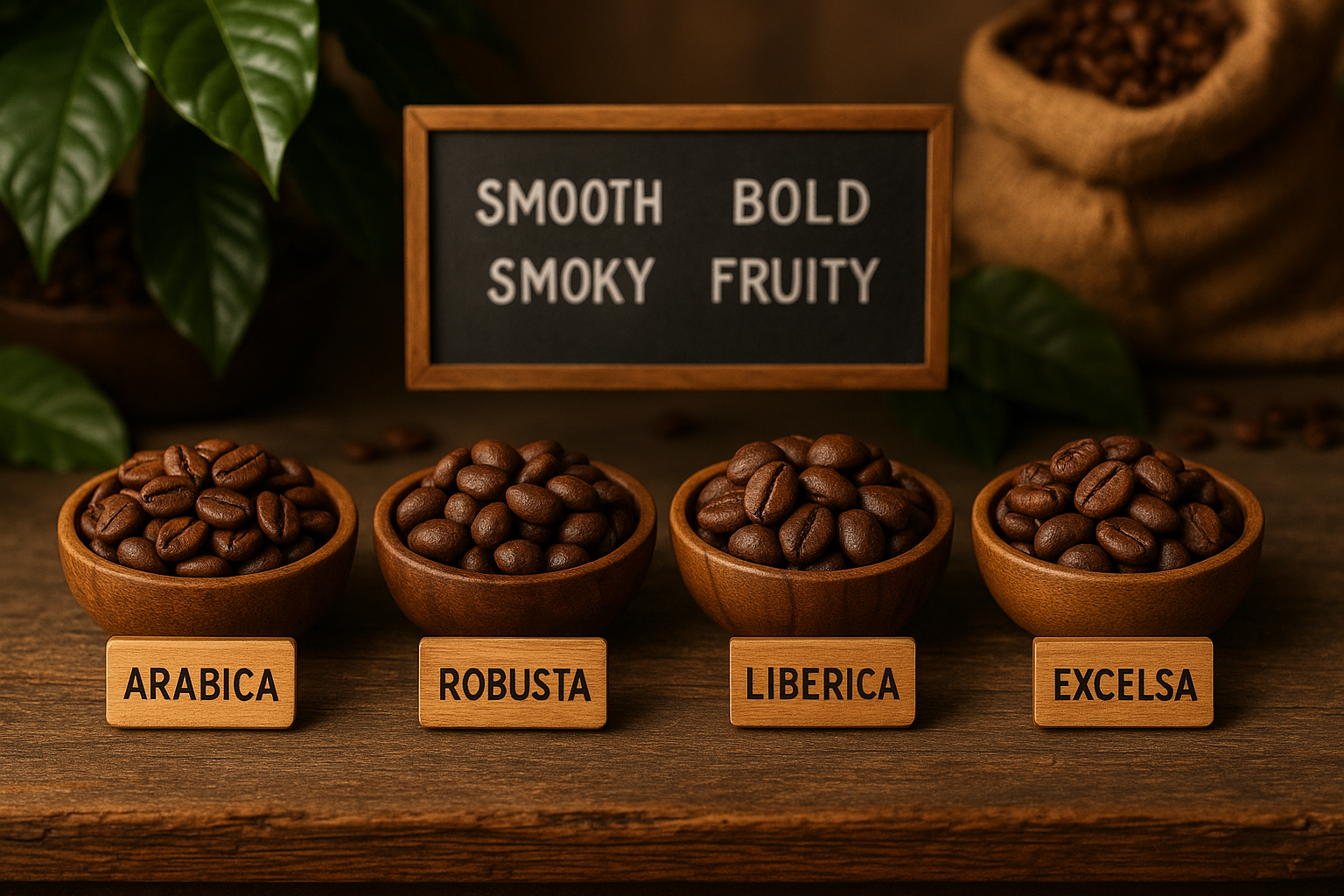Coffee isn’t just one universal drink. At the root of every brew is the coffee bean—and there’s more variety than most people realize. Different beans offer different flavors, aromas, and experiences. In this guide, you’ll discover the main types of coffee beans, how they differ, and which one best suits your personal taste.
The Four Main Types of Coffee Beans
There are four primary types of coffee beans grown globally, each with distinct characteristics:
- Arabica (Coffea arabica)
- Robusta (Coffea canephora)
- Liberica (Coffea liberica)
- Excelsa (a variety of Liberica)
Let’s explore each one.
1. Arabica: The Smooth Favorite
Overview
Arabica is the most popular type of coffee bean, making up about 60–70% of global coffee production.
Flavor Profile
- Smooth, mild flavor
- Bright acidity
- Notes of fruit, chocolate, or floral tones
Characteristics
- Grows at high altitudes
- More delicate and harder to grow
- Lower caffeine content than Robusta
Best For
- People who enjoy smooth, balanced, and complex flavors
- Ideal for black coffee or light roasts
2. Robusta: The Strong and Bold
Overview
Robusta is the second most common coffee bean and is more resilient to pests and disease than Arabica.
Flavor Profile
- Strong, bitter, earthy
- Less acidic, more harsh
- Notes of nuts or wood
Characteristics
- Grows at lower altitudes
- Contains up to twice as much caffeine as Arabica
- Produces more crema in espresso
Best For
- People who like bold, strong coffee
- Often used in instant coffee and espresso blends
3. Liberica: The Wild Card
Overview
Liberica is rare and grown in limited regions like the Philippines and Malaysia.
Flavor Profile
- Smoky, woody, floral
- Unique and bold, sometimes fruity or wine-like
Characteristics
- Large, irregular-shaped beans
- Low acidity, complex aroma
Best For
- Adventurous coffee drinkers
- Those seeking something different and exotic
4. Excelsa: The Complex Variant
Overview
Excelsa is technically a variety of Liberica but has a distinct taste profile and is grown mainly in Southeast Asia.
Flavor Profile
- Tart, fruity, dark, and mysterious
- Bright notes with a roasted finish
Characteristics
- Often used in blends to add depth
- Very low availability
Best For
- Coffee enthusiasts looking for layered, surprising flavors
Arabica vs. Robusta: A Head-to-Head
| Feature | Arabica | Robusta |
|---|---|---|
| Taste | Mild, sweet, complex | Bitter, bold, earthy |
| Caffeine | Low (~1.5%) | High (~2.7%) |
| Acidity | Higher | Lower |
| Body | Light to medium | Full and heavy |
| Price | More expensive | More affordable |
| Usage | Specialty, cafés | Instant, blends |
How to Choose the Right Bean for You
Here’s a simple taste quiz to help guide your preference:
- Do you like sweet, smooth, and light coffee? → Go with Arabica.
- Prefer strong, full-bodied brews? → Try Robusta.
- Looking for an unusual, smoky experience? → Explore Liberica.
- Want something fruity and layered? → Seek out Excelsa.
Where These Beans Grow
- Arabica: Ethiopia, Colombia, Brazil, Costa Rica, Guatemala
- Robusta: Vietnam, India, Indonesia, parts of Africa
- Liberica & Excelsa: Philippines, Malaysia, parts of Southeast Asia
Climate, altitude, and soil all affect how these beans taste when roasted and brewed.
Blends vs. Single-Origin
- Blends mix Arabica and Robusta to balance flavor and strength.
- Single-origin beans come from one region or farm, offering unique taste profiles.
Tip: Start with single-origin Arabica to understand your preferences.
Roast Level Matters Too
Each bean type can taste dramatically different based on how it’s roasted:
- Light Roast: Retains origin flavor—great for Arabica.
- Medium Roast: Balanced and sweet—works well for both.
- Dark Roast: Bold, smoky—often used for Robusta.
Experiment to find your favorite combo of bean + roast.
Final Sip: Discover Your Bean Personality
The world of coffee beans is richer than most people realize. Whether you’re sipping a smooth Arabica on a slow morning or powering through with a bold Robusta, knowing your bean makes the experience more rewarding.
Try different beans, track your preferences, and enjoy the journey—your perfect cup is out there, waiting for you.
